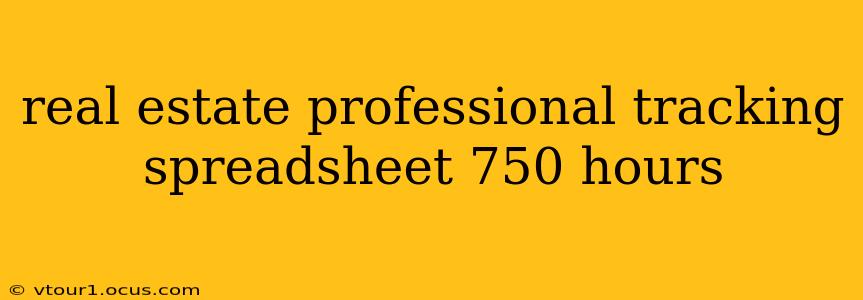The real estate industry thrives on productivity. To truly succeed, you need more than just charm and market knowledge; you need meticulous tracking of your time and activities. This is where a well-designed real estate professional tracking spreadsheet becomes invaluable. Whether you're aiming to meet licensing requirements, optimize your business strategy, or simply gain a clearer understanding of your workload, a robust spreadsheet can be your secret weapon. This guide will walk you through creating a powerful tracking system that helps you manage your 750 hours (or more!) effectively.
Why Track Your Time as a Real Estate Professional?
Tracking your time isn't just about meeting minimum hour requirements; it's a crucial step toward maximizing your efficiency and profitability. By meticulously recording your activities, you can:
- Identify Time Wasters: Pinpoint tasks that consume excessive time without yielding significant returns. This allows for strategic adjustments and improved time management.
- Optimize Your Workflow: Analyze your data to see which activities contribute most to your success. This enables you to refine your processes and focus on high-impact tasks.
- Improve Client Communication: Accurately track your interactions with clients to provide better service and updates.
- Demonstrate Compliance: Maintain accurate records to satisfy licensing and regulatory requirements.
- Set Realistic Goals: Gain a realistic understanding of your workload and set achievable goals for future periods.
- Measure Your Success: Track key performance indicators (KPIs) such as client acquisition, deal closure rates, and overall revenue generated per hour.
What Should Be Included in Your Real Estate Tracking Spreadsheet?
Your spreadsheet should be more than just a simple time log. It needs to provide comprehensive data for insightful analysis. Here's a suggested framework:
Essential Columns:
- Date: The date the activity occurred.
- Time In: Start time of the activity.
- Time Out: End time of the activity.
- Total Time (Hours): Calculated duration of the activity.
- Activity Type: Categorize activities (e.g., client meetings, marketing, administrative tasks, property showings, networking, continuing education). Consider using a drop-down menu for consistency.
- Client Name (if applicable): Link the time spent to specific clients.
- Property Address (if applicable): Track time spent on individual properties.
- Notes: Add any relevant details about the activity. This could include follow-up actions, outcomes, or challenges encountered.
- Task Status: Mark tasks as completed, in progress, or pending.
- Revenue Generated (if applicable): Track direct revenue generated from each activity.
Advanced Features (Consider adding these based on your needs):
- Project Management Integration: Link your spreadsheet to your project management software for seamless data flow.
- Customizable Fields: Add additional columns based on your specific business needs (e.g., marketing campaign names, lead source).
- Automated Calculations: Utilize spreadsheet formulas to calculate weekly/monthly totals, average time per activity, and other relevant metrics.
- Charts and Graphs: Visualize your data with charts and graphs to identify trends and patterns quickly.
H2: What are some common time-tracking methods for real estate professionals?
Several methods exist for tracking your time, each with its pros and cons. These include manual time logs (like the spreadsheet discussed above), dedicated time tracking software (many offer real estate-specific features), and even mobile apps designed for easy time entry on the go. Choosing the right method depends on your preferences, technological comfort, and the complexity of your business needs. Many agents find a combination of methods most effective.
H2: How can I improve my time management skills as a real estate agent?
Improving time management goes hand-in-hand with accurate tracking. Once you have a clear picture of where your time is going, you can implement strategies to boost productivity:
- Prioritize Tasks: Use methods like the Eisenhower Matrix (urgent/important) to focus on high-impact activities.
- Batch Similar Tasks: Group similar tasks together to minimize context switching and increase efficiency.
- Delegate When Possible: Outsource tasks that don't require your direct attention.
- Schedule Dedicated Work Blocks: Set aside specific times for focused work, minimizing interruptions.
- Utilize Technology: Leverage technology to automate repetitive tasks and streamline workflows.
- Set Realistic Goals: Avoid overcommitment and set achievable goals to avoid burnout.
- Regularly Review and Adjust: Analyze your tracking data regularly and adjust your strategies accordingly.
H2: What are some examples of activities to track in my real estate spreadsheet?
Examples of activities you should track include:
- Client Meetings: Initial consultations, follow-up calls, property viewings, closing meetings.
- Marketing Activities: Creating marketing materials, social media management, networking events, open houses.
- Administrative Tasks: Email correspondence, paperwork, contract review, property research.
- Property Showings: Time spent showing properties to clients.
- Continuing Education: Attending courses, workshops, or seminars.
- Lead Generation: Time spent on activities aimed at generating new leads.
By diligently tracking your activities and analyzing the data, you'll gain valuable insights into your productivity, allowing you to refine your strategies and ultimately achieve greater success in the competitive real estate market. Remember, a well-maintained tracking spreadsheet is an investment in your professional growth and financial success.
